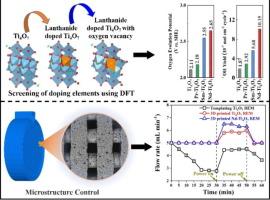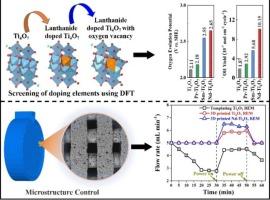3D printed lanthanide-doped Ti4O7 reactive membrane for efficient electrochemical disinfection and degradation of antibiotic resistance genes
IF 13.3
1区 工程技术
Q1 ENGINEERING, CHEMICAL
引用次数: 0
Abstract
Simultaneous removal of antibiotic resistant bacteria (ARB) and antibiotic resistance genes (ARGs) is absolutely imperative to prevent the spread of antibiotic resistance in the environment. Herein, suitable dopants of Ti4O7 anode from the lanthanide elements were firstly selected to boost Ti4O7 electrooxidation ability according to density functional theory simulation. 3D printing technology was further adopted to prepare 3D printed lanthanide-doped reactive electrochemical membrane (REM) electrodes, which could efficiently avoid the problem of membrane clogging in the electrochemical filtration operation and increase the hydroxyl radical yield by 56–442 % compared to Ti4O7 REM. We found that complete inactivation (>8.0-log inactivation) of antibiotic resistant Escherichia coli (AR E. coli) was achieved during Nd-Ti4O7 REM (1 wt% Nd) treatment in a single pass at 4 mA cm−2, indicating significant improvement of disinfection efficiency than Ti4O7 REM (3.3-log inactivation) operated in same conditions occurred. Morphology characterization results of treated AR E. coli revealed that cytoplasmic leakage in cell membrane perforation was the main inactivation mechanism. In addition, Nd-Ti4O7 REM also exhibited better electrooxidation efficiency for ARGs removal, thereby eliminating the spread risk of antibiotic resistance. These findings greatly promoted the preparation and application of Ti4O7 REM with highly efficient electrooxidation ability in the treatment of wastewater containing an abundance of antibiotic resistant bacteria.


用于高效电化学消毒和降解抗生素耐药基因的 3D 打印掺杂镧系元素的 Ti4O7 活性膜
同时去除抗生素耐药菌(ARB)和抗生素耐药基因(ARGs)是防止环境中抗生素耐药性扩散的当务之急。在此,首先根据密度泛函理论模拟,从镧系元素中选择合适的掺杂剂来提高Ti4O7阳极的电氧化能力。进一步采用三维打印技术制备了掺杂镧系元素的三维打印反应电化学膜(REM)电极,有效避免了电化学过滤操作中膜堵塞的问题,与Ti4O7 REM相比,羟基自由基产率提高了56%-442%。我们发现,在 4 mA cm-2 的条件下一次通过 Nd-Ti4O7 REM(1 wt% Nd)处理抗生素耐药大肠杆菌(AR 大肠杆菌)时,可实现完全灭活(8.0-log 灭活),表明消毒效率比相同条件下运行的 Ti4O7 REM(3.3-log 灭活)有显著提高。经处理的 AR 大肠杆菌的形态学表征结果显示,细胞膜穿孔中的细胞质渗漏是主要的灭活机制。此外,Nd-Ti4O7 REM 在去除 ARGs 方面也表现出更高的电氧化效率,从而消除了抗生素耐药性扩散的风险。这些发现极大地推动了具有高效电氧化能力的 Ti4O7 REM 的制备和在处理含有大量抗生素耐药菌的废水中的应用。
本文章由计算机程序翻译,如有差异,请以英文原文为准。
求助全文
约1分钟内获得全文
求助全文
来源期刊

Chemical Engineering Journal
工程技术-工程:化工
CiteScore
21.70
自引率
9.30%
发文量
6781
审稿时长
2.4 months
期刊介绍:
The Chemical Engineering Journal is an international research journal that invites contributions of original and novel fundamental research. It aims to provide an international platform for presenting original fundamental research, interpretative reviews, and discussions on new developments in chemical engineering. The journal welcomes papers that describe novel theory and its practical application, as well as those that demonstrate the transfer of techniques from other disciplines. It also welcomes reports on carefully conducted experimental work that is soundly interpreted. The main focus of the journal is on original and rigorous research results that have broad significance. The Catalysis section within the Chemical Engineering Journal focuses specifically on Experimental and Theoretical studies in the fields of heterogeneous catalysis, molecular catalysis, and biocatalysis. These studies have industrial impact on various sectors such as chemicals, energy, materials, foods, healthcare, and environmental protection.
 求助内容:
求助内容: 应助结果提醒方式:
应助结果提醒方式:


